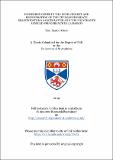Files in this item
Homeobox genes in the development and regeneration of the cephalochordate Branchiostoma lanceolatum and the polychaete annelid Spirobranchus lamarcki
Item metadata
| dc.contributor.advisor | Somorjai, Ildikó Maureen Lara | |
| dc.contributor.advisor | Ferrier, David Ellard Keith | |
| dc.contributor.author | Barton-Owen, Tom | |
| dc.coverage.spatial | 324 p. | en_US |
| dc.date.accessioned | 2019-06-26T14:35:24Z | |
| dc.date.available | 2019-06-26T14:35:24Z | |
| dc.date.issued | 2019 | |
| dc.identifier.uri | https://hdl.handle.net/10023/17973 | |
| dc.description.abstract | The development of complex animal morphology requires the extremely sophisticated spatiotemporal coordination of cell behaviour and communication. Homeobox genes encode transcription factors that are deployed in developmental processes to control the expression of other genes in particular locations and contexts. Many homeobox genes are highly conserved and act in similar roles between distantly-related animals that derive from the roles of their ancestral orthologues. The way that these genes have differentially evolved between taxa, and the effect that these changes have on the development and morphology of animals, is critical to our understanding of metazoan evolution. One particular developmental context, the regeneration of missing tissue, offers a unique perspective on evolutionary developmental biology because of its relationship to ontogenic development and its surprising diversity of retention and process between animal taxa. I examined the homeobox gene content of transcriptomes taken from the mature and regenerating tissue of the post-anal tail of Branchiostoma lanceolatum, a well-studied cephalochordate with a highly conserved genome, and the evolutionarily novel operculum of Spirobranchus lamarcki, a sedentarian annelid. In S. lamarcki regeneration, a diverse variety of homeobox genes is expressed, and the regenerative expression response is substantial. The discovery of several difficult-to-classify homeobox genes lead to the substantial expansion and improvement of the classification of a variety of homeobox genes undergoing unusual rapid and expansive evolution in the Spiralia, including dozens of TALE and PRD class genes, a new orthology group, and a strange S. lamarcki Hox gene. In B. lanceolatum, a similar diversity of expressed genes is observed but a milder regenerative response. One transcriptomic sequence in particular, identified as Pax3/7, led to the discovery that this well-studied gene has a previously unnoticed duplication in cephalochordates. This discovery has implications for ongoing study of vertebrate and cephalochordate neural plate border evolution. | en_US |
| dc.language.iso | en | en_US |
| dc.publisher | University of St Andrews | |
| dc.subject.lcc | QH447.8H65B2 | |
| dc.subject.lcsh | Homeobox genes | en |
| dc.subject.lcsh | Cephalochordata--Genetics | en |
| dc.subject.lcsh | Polychaeta--Genetics | en |
| dc.title | Homeobox genes in the development and regeneration of the cephalochordate Branchiostoma lanceolatum and the polychaete annelid Spirobranchus lamarcki | en_US |
| dc.type | Thesis | en_US |
| dc.contributor.sponsor | University of St Andrews. School of Biology | en_US |
| dc.type.qualificationlevel | Doctoral | en_US |
| dc.type.qualificationname | PhD Doctor of Philosophy | en_US |
| dc.publisher.institution | The University of St Andrews | en_US |
| dc.identifier.doi | https://doi.org/10.17630/10023-17973 |
This item appears in the following Collection(s)
Items in the St Andrews Research Repository are protected by copyright, with all rights reserved, unless otherwise indicated.

